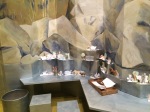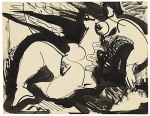“The wind carried away the cottonwool
At five in the afternoon.
And the oxide scattered crystal and nickel
At five in the afternoon”. Garcia Lorca: Lament for Ignacio Sanchez Mejias.

Burning elegy artists proof
Canberra in winter is bitingly cold, a stark blue sky and cool grey concrete of the National Gallery seems like a world away from Spain and New York but the last couple of days I’ve felt the intensity of bullfights and the pain in painting.
 Robert Motherwell : At Five in the Afternoon currently at the National Gallery is a selection of prints from the Gallery’s collection and the curator Jane Kinsman gave a talk and some insight into Motherwells practice of printmaking. The works spread across three rooms were brilliantly curated and each work was fabulous but a selection of small lithographs were simple and exquisite and captured the same emotions of the larger striking painterly works.
Robert Motherwell : At Five in the Afternoon currently at the National Gallery is a selection of prints from the Gallery’s collection and the curator Jane Kinsman gave a talk and some insight into Motherwells practice of printmaking. The works spread across three rooms were brilliantly curated and each work was fabulous but a selection of small lithographs were simple and exquisite and captured the same emotions of the larger striking painterly works.

Lament for Lorca:
Some of the larger prints utilising graphics from cigarette packets reinforced that peculiar artist habit of finding inspiration in the mundane. I remember as a child enamoured with the cigarette packets we used to sell in the boat hire business, Camel and Fiesta were my favourites but later I photographed old packets a friend had in their scrapbook for painted works not realising Motherwell too was drawn by the colour and shape. Up until stumbling across John’s curious arty collection, I had tried to draw a camel packet from memory.

Motherwell: Hermitage
 Motherwell’s prints incorporating imagery and my painted works, now capture a lost period. Smoking was acceptable and a filthy dangerous habit that I (for a short time) and Motherwell embraced. Packets were bright and engaging. Cigarette packaging in Australia is now a dark, dull, khaki green and the only images gangrenous limbs and health warnings. And I guess like any image, even cancerous body parts and minimalist packaging will provide some sort of inspiration for other artists down the line.
Motherwell’s prints incorporating imagery and my painted works, now capture a lost period. Smoking was acceptable and a filthy dangerous habit that I (for a short time) and Motherwell embraced. Packets were bright and engaging. Cigarette packaging in Australia is now a dark, dull, khaki green and the only images gangrenous limbs and health warnings. And I guess like any image, even cancerous body parts and minimalist packaging will provide some sort of inspiration for other artists down the line.
After the talk, we hit the wine and felt glad Motherwell had chosen drinking and painting over suicide. We are so much richer for his work and his immersion in the poetry of Lorca. We went back again the next day for another hit before heading home, did a swing by the Indigenous and Australian gallery and we had a choice – down the stairs or back through the exhibition?
I’D RATHER GO BY MOTHERWELL THAN A STAIRWELL.

Detail from my Peter Stuyvesant painting


 Fiona Hall was a very early influence on the way I thought about art. I had first seen her work “Dead in the Water” at the Art Gallery of NSW more than 15 years ago in a group exhibition and can’t recall the theme of the exhibition. She had drilled small holes in plastic piping and suspended them in a glass tank. I was impressed with the way she was able to get her message across and the skill in presentation. She was selected to represent Australia in the 2015 Venice Biennale and the show, Wrong Way Time, was displayed at the National Gallery of Australia in Canberra along with her earlier works in the NGA collection.
Fiona Hall was a very early influence on the way I thought about art. I had first seen her work “Dead in the Water” at the Art Gallery of NSW more than 15 years ago in a group exhibition and can’t recall the theme of the exhibition. She had drilled small holes in plastic piping and suspended them in a glass tank. I was impressed with the way she was able to get her message across and the skill in presentation. She was selected to represent Australia in the 2015 Venice Biennale and the show, Wrong Way Time, was displayed at the National Gallery of Australia in Canberra along with her earlier works in the NGA collection.






























 A few nights ago I went to Jackson Pollock’s and Morris Louis’ birthday party – 100 years celebration at the NGA where they transformed the sculpture garden restaurant into the Cedar Tavern for an event named “New York State of Mind”.
A few nights ago I went to Jackson Pollock’s and Morris Louis’ birthday party – 100 years celebration at the NGA where they transformed the sculpture garden restaurant into the Cedar Tavern for an event named “New York State of Mind”. A gallery named after a man who had never been to the
A gallery named after a man who had never been to the  During the talk the curator referred to this gallery as the end of the “Y” referring to the shape of the overall exhibition. This is almost the last area of the Abstract Expressionism exhibition and it is an amazing collective of abstract artists.
During the talk the curator referred to this gallery as the end of the “Y” referring to the shape of the overall exhibition. This is almost the last area of the Abstract Expressionism exhibition and it is an amazing collective of abstract artists. 























 I have put the majority of works in this room on this post but I stopped. The last work a collage by Lee Krasner felt enough for now, the next two walls were works that deserved a separate post. And I didn’t make up my mind about the best work after all, but I’m leaning towards Hans Hofmann, it feels very important spatially to me. I think I have learnt in the last few posts more about Hofmanns work than I expected and where I thought it was about the colour it turns out to be about the space. I love seeing artists in unexpected ways.
I have put the majority of works in this room on this post but I stopped. The last work a collage by Lee Krasner felt enough for now, the next two walls were works that deserved a separate post. And I didn’t make up my mind about the best work after all, but I’m leaning towards Hans Hofmann, it feels very important spatially to me. I think I have learnt in the last few posts more about Hofmanns work than I expected and where I thought it was about the colour it turns out to be about the space. I love seeing artists in unexpected ways.











